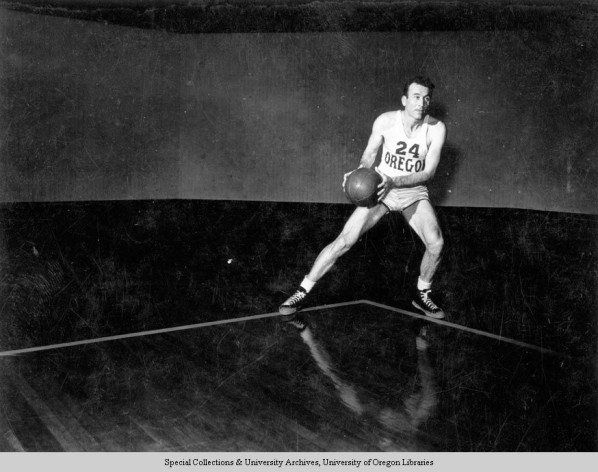Putting Oregon on the Map
 The University continued to introduce new athletic endeavors on campus during this era, while the major sports proceeded to gain in prominence.
The University continued to introduce new athletic endeavors on campus during this era, while the major sports proceeded to gain in prominence.
A variety of new recreational activities entered the scene, including skiing, which began as a club sport in 1938 and Orchesis (modern dance), which began in 1944. Also noteworthy was the promotion of wrestling to major sport status in 1954. Six years later gymnastics joined the intercollegiate offerings. Despite the modest gains made by the less-popular sports during this time, the major sports, including basketball, track and field, and football, experienced the most change.
Soaring to New Heights
With the advent of a new basketball arena in 1926, the sport blossomed in popularity, particularly after Oregon won the first NCAA Championship in 1939. During World War II, the University’s Athletic Board decided basketball would be the school’s only collegiate sport for the 1944-45 academic term.
Coinciding with the growth of basketball was a significant growth in football. Both began emerging as the major revenue sports for the University, thus a more concerted effort to increase the success and prestige of the programs was organized. In 1949, the football team became the first Pacific Coast Conference school to play in a bowl game other than the Rose Bowl. Oregon took on Southern Methodist University in the Cotton Bowl, but was defeated 21-13. The game marked Oregon’s first appearance in a bowl game since 1920. By 1967, the football team had a new home, Autzen Stadium, and was in a battle to remain competitive not only in the Pac-8 Conference (of which Oregon became a member in 1965) but also on the national level.
Track and field at Oregon also continued to carve out a notable reputation when Bill Bowerman took over as head coach in 1949. A steady tradition of world-renowned athletes graced the track, and numerous team titles helped Oregon gain national respect as a track and field institution.
 Behind the Pack
Behind the Pack
As Oregon positioned itself as a major NCAA competitor in numerous sports, the women’s offerings were limping behind. Although field hockey continued to increase in popularity on campus, few other sports (except for intramural offerings) emerged for women until the late 1960s. In 1967, Oregon’s first intercollegiate volleyball team stepped up to the net. In the 1970s, the women’s track team also began competing against other schools. However, as the next decade approached, the University encountered challenges in maintaining the prestige and prominence of the emerging men’s intercollegiate sports, while working to build the women’s offerings. The advent of Title IX in 1972 only added to these pressures.